There's no better time than summertime to get acquainted with one of my favorite sauces in the world - pesto. The formula for pesto is pretty simple - fresh greens, nuts, and cheese pounded or processed together. But there are (limitless) variations to the traditional basil pesto. This post has my tried-and-tested basil pesto recipe. It also has answers to common questions about how you can improvise if you don't have the exact ingredients.
This post contains helpful tips and tricks! If you're in a rush, please use the "Jump to Recipe" below!
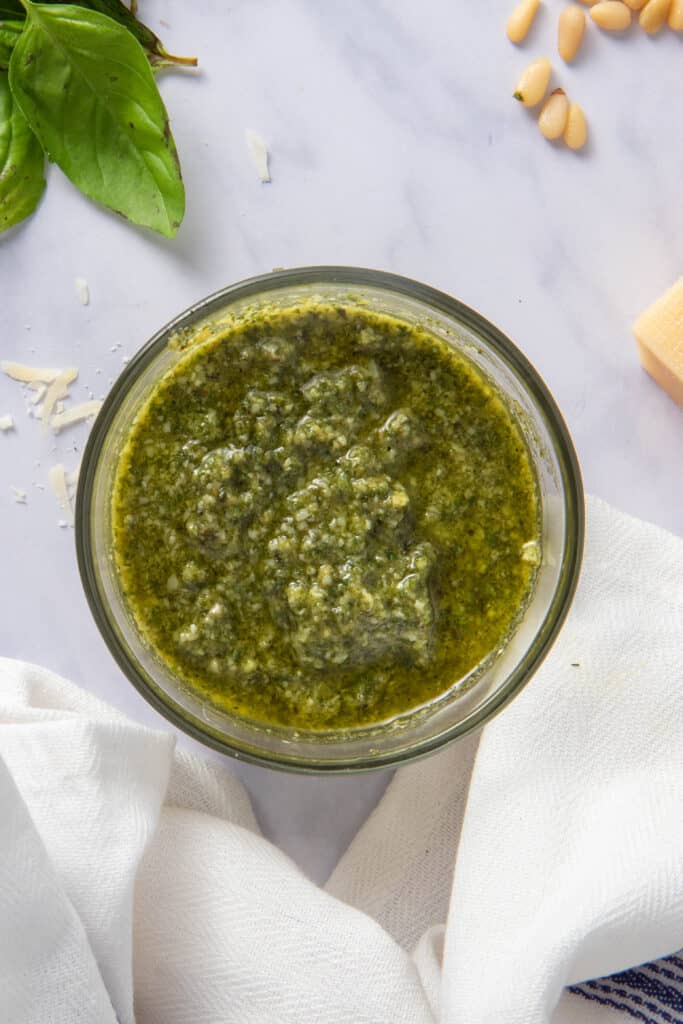
Pesto (meaning, "pounded" in Italian) has become a catch all word used to describe many different things today. It originated in Italy as a mortar-and-pestle ground, coarse sauce made of basil, pine nuts, garlic, Parmesan, and olive oil. Most Italians would accept that the traditional recipe we think about derives from Genoa, in Northern Italy, i.e. pesto alla Genovese.
📋 Ingredients & variations
Traditional pesto (aka pesto alla Genovese) is made with six ingredients. You need fresh basil, pine nuts, garlic, Parmesan, olive oil (preferably extra virgin) and salt. I use a recipe that I have been using for 6+ years now, since when I lived in Italy. This traditional recipe is simple, so the ingredients make a huge difference to the quality of your pesto.
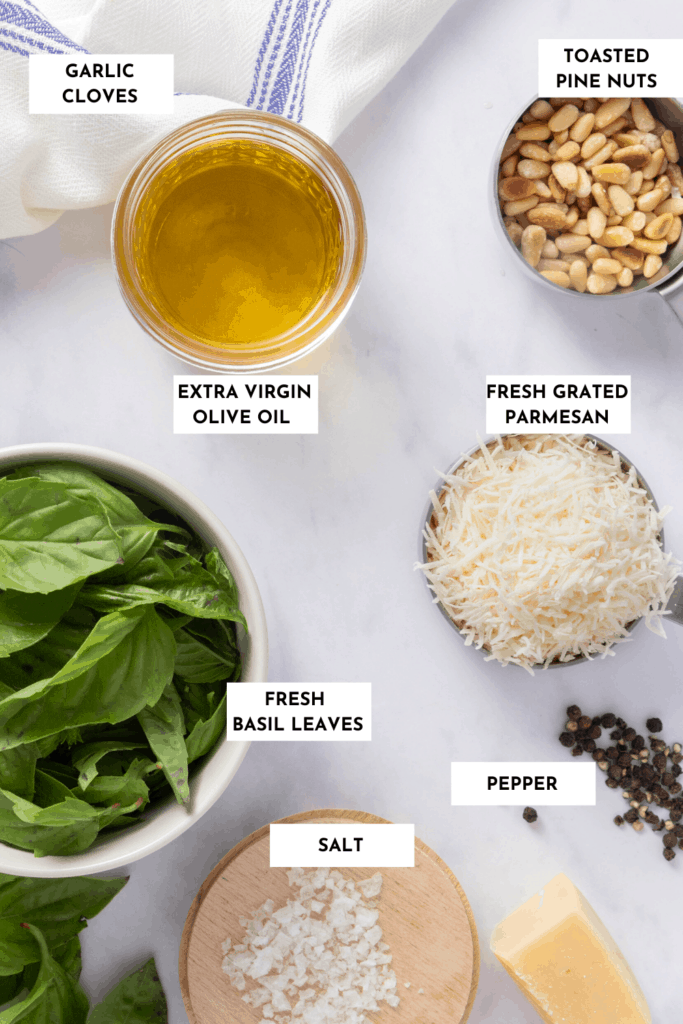
🥬 What can I use instead of basil?
Basil is the traditional green that's used to make pesto, but in recent times, kale has become the rebellious favorite. If you have the smallest spot or a nice airy and sunny area, you can grow basil at home! If not, you can even get a "living basil" pot from your grocery store and place it on your counter. But try to get the freshest basil you can for pesto!
However, you can use almost any type of green that has some structure and a mild bitter flavor. In addition to basil, I've made pesto with arugula (rocket), spinach, baby chard, carrot tops, and of course, blanched kale. I tend to use basil in the summer for basil pesto and kale in the winter.
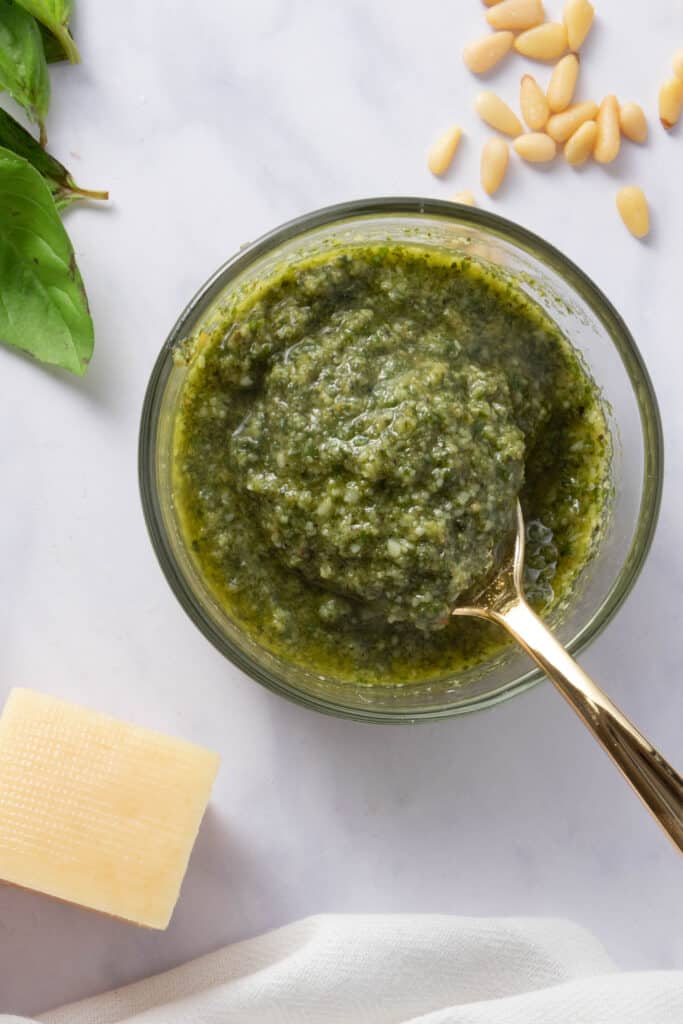
🥜 What can I use instead of pine nuts?
Pine nuts are traditionally used in this recipe. But they can get expensive, so I've substituted them with almonds, walnuts, and more recently, cashews, to get incredible flavors. If you can't get pine nuts (or prefer not to) you can use almost any nut or seed.
Based on a suggestion from Masterclass, I made pesto using pepitas (shelled sunflower seeds) for a friend who has a nut allergy. And it tasted quite delicious - so that's my go-to option when I can't find pine nuts. One thing you should do is to toast the nuts or seeds before you use them - this brings out the "nutty" flavor and adds some amazing notes to the pesto.
🧀 What kind of cheese should I use to make pesto?
The traditional recipe I've seen calls for parmigiano reggiano, but I've made pesto with similar hard, sharp cheeses (e.g. pecorino romano). I've left out the cheese entirely or added nutritional yeast or vegetarian Parmesan to accommodate dietary restrictions as well. You can leave it out when you're grinding and add it at the end to your pasta directly too.
👩🏽🍳 Top tips and troubleshooting
How to make pesto?
You can make pesto with a food processor or a mortar and pestle. I've done both. One thing to note - the stainless steel blades will sometimes make the basil oxidize faster and lead to browning. To prevent that, I suggest placing the bowl and blades in the fridge for a few minutes before you grind pesto.
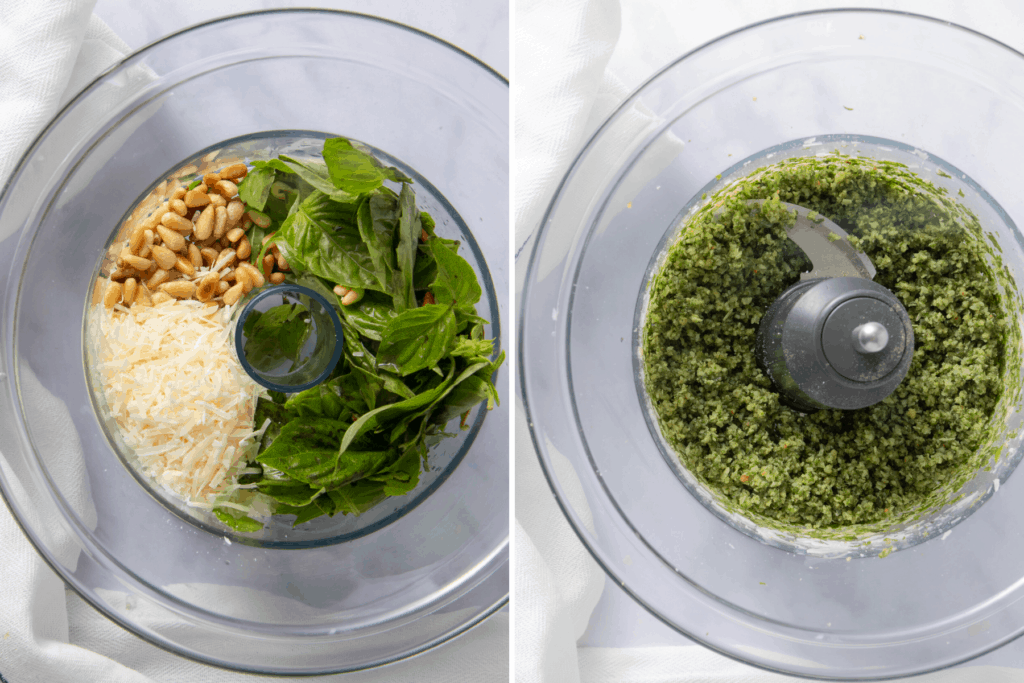
If your food processor does not have a spout for olive oil, no worries - just add by hand and mix slowly to combine. If using a mortar and pestle (or a "heavy" spatula) add ingredients slowly to combine them well.
Making creamy pesto
Traditional Italian basil pesto is not creamy, but most pesto available in US restaurants add cream to give it a richer flavor and consistency. One way to do this is to add cream (duh!). But I prefer a non-dairy way to accomplish the same effect: by using avocados instead. Avocados are delicious, full of good fat and add that creaminess that I often crave when I'm eating pasta. On that note, check out my creamy vegan kale pesto recipe (totally vegan) where I use avocados and cashews!
Using basil stems in your pesto
When the basil stem is too thick, it starts to get bitter. It can also mess up your food processor if it's too "hard" - so I typically chop off older parts of the main stem. But the finer stems have never given me any trouble.
Cooking your pesto (please don't!)
A quick note on serving pesto: you should never "cook" with pesto. The beauty of this sauce is in the fresh flavors that it brings out when added to almost any dish. For most pasta dishes, you cook the pasta almost al dente and then finish cooking the pasta in the sauce. This doesn't work for pesto.
Instead, you should bring the pesto to room temperature. Once the pasta is cooked, reserve some of the pasta water. Then, transfer pasta to a mixing bowl, add pesto and some pasta water until it comes together. Bonus points for serving in a warm bowl so it doesn't clump!
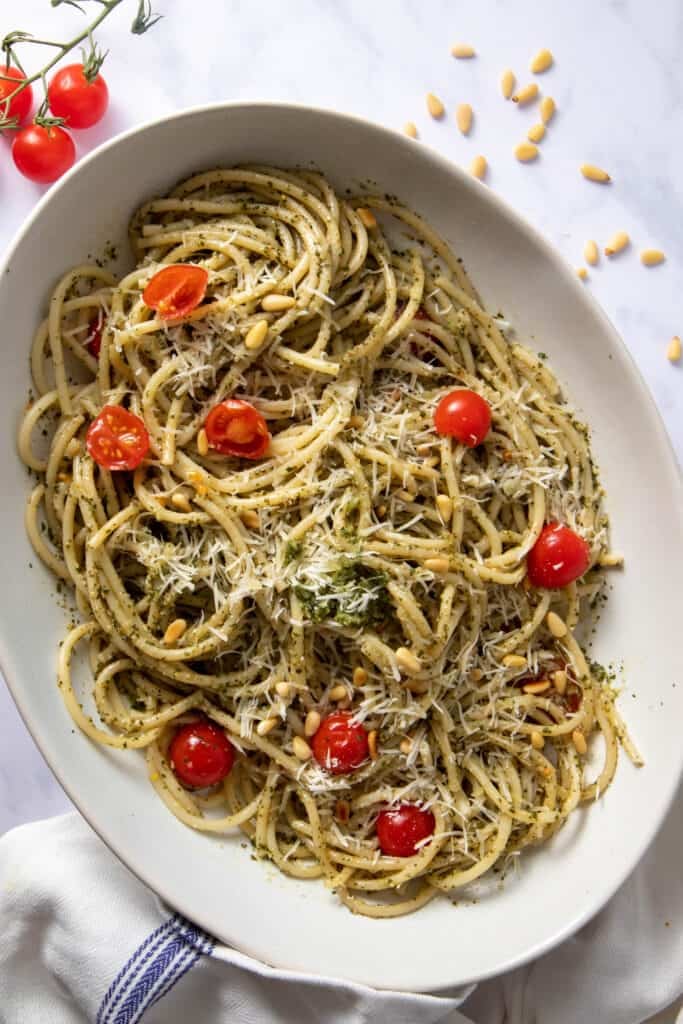
Storing and freezing your pesto
This really depends on the type of pesto and how you store it. I typically use airtight containers and store my pesto in the fridge. If I make ridiculous quantities (think, end-of-summer basil bounty) - I portion and freeze.
When stored in the fridge, pesto lasts 4 - 5 days on average, if continuously refrigerated. In the freezer, it lasts 2 - 3 months. That said, I've found that non-dairy recipes typically tend to keep a bit longer in the fridge. And if you used an avocado in the pesto, it does tend to brown a lot faster. To prevent pesto from browning, I'll add a thin layer of olive oil on top.
🍴 Eight ways to eat pesto (beyond pasta)
Where do I even start with all the ways you can eat pesto?! Other than the delicious pasta (picture above, or like this pesto veggie pasta recipe) I've also rounded up eight ways in which you can devour this ultra versatile sauce.
- Pesto Dip: Add a bit of pesto to sour cream, cheese, yogurt or even guacamole to make a vibrant dip for the summer!
- Put it on pizza: I love to use pesto in place for the traditional red sauce on pizza. A little goes a long way, so I try to not use as much of it. Top with mushrooms, arugula, cheese.
- Bake bread with it (or slather on top): What makes a perfect loaf of bread even better? Fold pesto into the dough, or add it on top as a spread. Have you ever made pesto grilled cheese? Delicious.
- Add a dollop on soups and stews: My long kept secret. Next time you make a creamy soup, just add a spoonful of pesto on top. This gives such a fresh herby flavor to the soup - game changer!
- Toss your vegetables in it: Especially when you oven or pan roast vegetables. Drizzle a few spoons of pesto on top and you're set.
- Add some to your salad dressing: Oh where do I start? Whether it's a vibrant summer salad with a lemony vinaigrette or even a rainbow slaw, you can add a spoonful of pesto to top up flavors!
- Add it to toast or over eggs. When I make a simple (but delicious) avocado toast, I love adding a spoonful of pesto on top. Any sandwich or toast you make, or even scrambled eggs, will taste better with pesto
- Did someone say quesadilla?! Here's the thing - tacos, quesadillas, and burritos all taste great with pesto. I've added it to tacos (like my Korean gochujang cauliflower taco with a slight drizzle of pesto)
- Pasta: Okay, I cheated but I HAVE to include pasta here. I have a reputation for eating insane amounts of pesto pasta. My favorite is fusili with pesto, breadcrumbs, and cherry tomatoes, topped with more Parmesan.
If you try this recipe, let me know! Leave a comment, rate the recipe, and tag #urbanfarmie on Instagram, @urbanfarmie on Pinterest!
📖 Recipe
Traditional Basil Pesto (Pesto alla Genovese)
Equipment
- Food Processor (or Mortar & Pestle)
Ingredients
- 1.5 cups basil leaves, packed, small variety (~75 small leaves)
- 2 tablespoon pine nuts, preferably toasted
- ⅓ cup Parmesan or Grana Padano cheese, freshly grated
- 2 cloves garlic, chopped and smashed
- ½ cup extra virgin olive oil
- ½ teaspoon salt, coarse salt if possible
Instructions
- Place your food processor bowl and blade in the fridge while you get the rest of the ingredients set up!
- Optional *but highly recommended: use a skillet to toast the pine nuts over medium, stirring frequently, for about 2 to 4 minutes. Let them cool.
- Wash the basil leaves and dry them thoroughly (they need to be dry!)
- Add the basil leaves, pine nuts, garlic, cheese, and salt to the bowl of the food processor and pulse until a coarse mixture forms
- Now, add the olive oil slowly through the spout of the food processor and pulse to combine until a smooth sauce forms. Note: if your food processor does not have a spout through which you can pour the olive oil, just add the oil slowly and use a spatula to combine as you pour!
Notes
- If you don't have a food processor, you can use a mortar and pestle - in fact, this is how it's traditionally done in Genoa!
- Most Parmesan cheese, unfortunately, is not vegetarian (they include calf rennet). Please make sure to use vegetarian Parmesan if you'd like to keep a certain diet!
- Don't cook the pesto when you use it in pasta! Instead, boil the pasta to instructions on package, reserve ⅓ cup of pasta water (per box of pasta cooked). Add the cooked pasta to a mixing bowl, add pesto and slowly add the pasta water and toss to combine. Garnish and serve for deliciousness!
Nutrition
If you tried this recipe, don't forget to comment and rate! ⭐⭐⭐⭐⭐




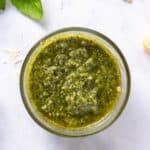








I think pesto's stereotypically a green-coloured Italian-style basil sauce of basil, pinenuts (or walnuts etc), grated cheese (often cheaply made with cheddar), and oil (sometimes ordinary vegetable oil with a touch of olive oil), but what they erroneously call pesto can be a sauce of rocket, broccoli, sundried (really oven-dried) tomatoes, or yellow capsicums, when I prefer classic basil pesto, literally meaning "crushed with a pestle", even though there are varieties made in a blender, commercially prepared pesto often uses walnuts and almonds, cheddar, and sheep's milk cheese, together with sweet basil, it's not very oily once you scoop it out of the jar, the pesto's rather dry, I tried it with the Sacla' variety, when I prefer Leggo's, I don't trust a non-vegetarian variety.
Enjoyed this fresh pesto with your tortellini salad recipe. What a difference maker. Loved how fresh it tasted and how it avoids the extra ingredients many commercially produced pestos contain. Another 5 star recipe!